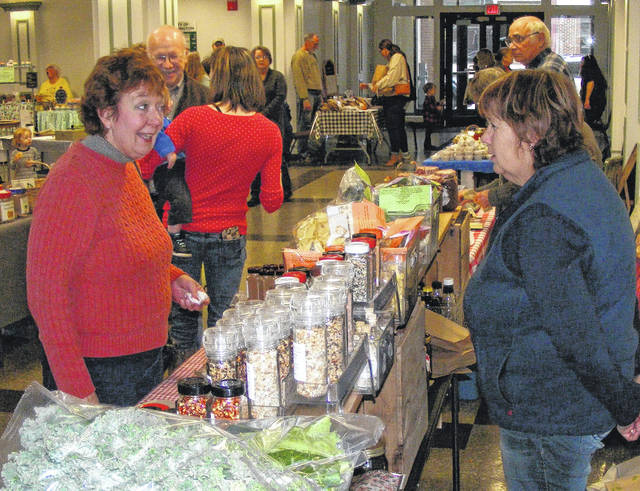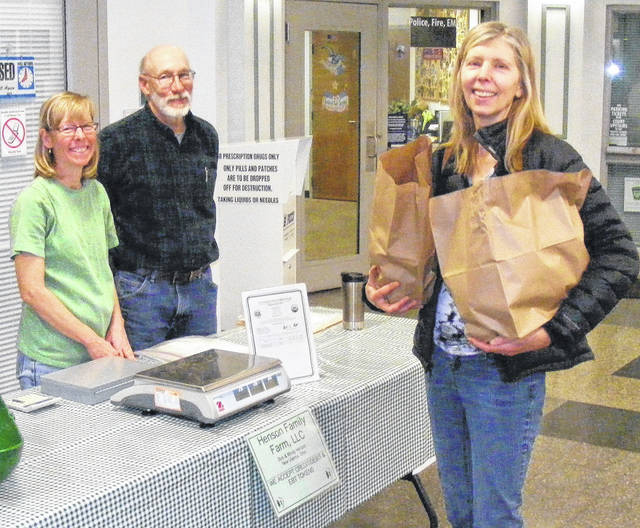

COLUMBUS — The U.S. economy is on the rise and farmers can look forward to a positive cash flow next year, according to agricultural industry experts.
Ohio and national farm incomes are expected to increase this year for the first time in four years, along with farm assets and equities, according to Ani Katchova, professor at The Ohio State University. Farm markets look strong and the financial stress which farmers are facing are at historic low rates since the economic downturn in recent years.
“Despite farmers having lower profit margins, they’re still in strong equity positions,” said Katchova, who is cautiously optimistic about the outlook for next year. The national increase in livestock sales and the previous year’s stored crops contribute to the farm income increase.
Katchova is an associate professor and Farm Income Enhancement chair in the Department of Agricultural, Environmental, and Development Economics at OSU.
Ohio land values remain high and Ohio farm bankruptcy rates have been about half of the national average, with very low delinquency rates on agricultural loans. Farm bankruptcy rates in Ohio have been less than one bankruptcy per 10,000 farms, about half of the national bankruptcy rate.
However, an unusual trend is that Ohio cash rents are stable and continue to increase while those in the U.S. have declined, according to Katchova.
“Financial conditions seem to be improving, albeit slowly. When I say improving, we’re coming from a low point in farm income,” Katchova said. “Hopefully, the worst is over.”
She said that while incomes should be up, there may be additional expenses, as well. Expenses for farmers are expected to increase caused by higher costs for hired labor, interest and fuel, with some declines in expenses for feed and fertilizer, Katchova said.
She pointed out that the downturn in farm income in recent years was not as severe as the dip experienced in the 1980s when grain prices dropped, farm debt soared and numerous farms went bankrupt. The 1980s was when the last agricultural economic slump occurred nationwide.
“We are in a very different situation than we were in the 1980s,” Katchova said.
Along with other agricultural experts, Katchova made her predictions at the annual Agricultural Policy and Outlook Conference Nov. 9 at Ohio State’s main campus, hosted by the Department of Agricultural, Environmental and Development Economics (AEDE).
The 2018 Farm Bill generates weighty topics in the agricultural sector, such as the importance of Free Trade Agreements (FTA) to U.S. agriculture. Ian Sheldon, Andersons Professor of International Trade addressed three significant FTAs.
“Agriculture has definitely benefited from the free trade agreements that we’ve been members of,” said Sheldon, “and we’ve thrown away the potential to join two major free trade agreements — TTP and TTIP — which I think would have significantly benefited the U.S. agricultural sector, including Ohio.”
The Trans-Pacific Partnership (TPP) was signed in October 2015 by the previous administration and has not been ratified. The Transatlantic Trade and Investment Partnership (TTIP) is a proposed agreement between the European Union and the U.S. Both countries have been backing away from this agreement and is essentially on hold.
Sheldon said that there are two issues which represent a key threat to the North American Free Trade Agreement (NAFTA), signed in 1994 between the U.S., Canada, and Mexico. First, The U.S. has proposed a five-year sunset clause, which would mean that every five years the U.S. seeks to evaluate the agreement and to view whether it wants to remain in NAFTA. Secondly, he said that the change in the rules of origin in the automobile sector is relatively significant.
Carl Zulauf, AEDE Professor Emeritus, addressed Congress enacting a new farm bill in 2018. Zulauf said that there are two principal reasons that this farm bill will be an extension: the last bill had a very difficult birthing process and there is a wide-spread desire to avoid that this time; and the second reason, “where’s the money going to come from?”
“Crop insurance is not the reason we are not in a financial crisis right now. It is the crop programs,” Zulauf referred to programs such as Agriculture Risk Coverage (ARC) and Price Loss Coverage (PLC).
Zulauf speculated that there will be some money added to the farm bill, but probably not as much as the farm and commodity groups and consumer advocates want. There has been a lot of discussion, especially among the conservative party, about cutting the Supplemental Nutrition Assistance Program (SNAP). He suggested a mandatory base update would save a lot of money and provide opportunities to use it elsewhere. Finally, he said people will look at crop insurance for cuts.
While there could be a need for monetary savings, millions of jobs are being created in the economy, according to George Mokrzan, Director of Economics, Huntington National Bank. He said payrolls and employment is growing at a sustained, solid rate.
“Going forward, my forecast for 2018 is that the commodity prices will rise above zero and be positive and we will have a positive price growth in both commodities and foods. And that will largely be because of the improvements of the overall world economy.” Mokrzan attributes this growth to massive monetary policy stimulus across the world.
Gary Schnitkey, Professor and Farm Management Specialist, Department of Agricultural and Consumer Economics, University of Illinois, agreed with Mokrzan that the U.S. is “getting back to normal” economically. However, his punchline was “If you haven’t liked the last three years, you’re not going to like the next three years.” Costs will probably not come down that much and he expects below $4 corn and similarly-priced soybeans.
In 2017, the U.S. had the largest production of soybeans ever, according to Schnitkey. 48 percent of U.S. soybeans are exported, and the major market is China. Meat requires corn and soybeans and as China’s meat intake increases, so will the pressure on the U.S. and Brazil to produce.
Soybeans are not the only crop skyrocketing—so is the demand for organic crops. Iryna Demko, Post-Doctoral Researcher in Agribusiness, Farm Income Enhancement Program, who was impromptu called to the podium to talk about organic foods imported from around the world.
“The big problem here is that we are not producing enough. And if you look at the U.S. organic acreages, they don’t increase,” said Demko. “But consumers here want to consume organic and that’s why we see this big increase in imports and is driven by organic feed demand here in order to sell organic.”
Ohio State is taking action to address these and other vitals issues in the agricultural sector. Ben Brown, Farm Management Program Manager, stepped on the stage with energy to speak about the Ohio Farm Business Analysis and Benchmarking Program at the Ohio State AEDE department.
“It’s a way to take farm level data and put it into a system,” said Brown, “and put out high quality financial reports, all the way down from cost to price, whole farm analysis, cost of production per acre, and machinery cost per acre.”
Brown added that he has a hard time saying farmers are in a financial crisis with land values where they are. “But I would be naive to say there aren’t farmers hurting.”
Comparing farms with this data will provide high quality data for researchers, farmers and lenders. The AEDE department is expanding this program and will be hiring additional staff and are currently recruiting farms to participate in the program.
You can view the webinar of this event on their website, www.aede.osu.edu, as well as other information about its future programs.



